
A telescope photo of the crescent Moon, probably from Lick Observatory.232K.
The U.S. Lunar Orbiter series returned many detailed views of the Moon, this one of the prominent crater Copernicus made by Lunar Orbiter V in August 1967. 1.7 MB
 Lunar Orbiter II obtained this oblique view of Copernicus
on November 28, 1966 from only 28.4 miles above the Moon. At the
time this was hailed as the 'Picture Of The Century'. 660K (cropped)
Lunar Orbiter II obtained this oblique view of Copernicus
on November 28, 1966 from only 28.4 miles above the Moon. At the
time this was hailed as the 'Picture Of The Century'. 660K (cropped)
![]() On August 23, 1966 Lunar Orbiter 1 obtained the first
view of the Earth from the vicinity of the Moon. Scanned from
an original print from a rare photographic edition of the NASA
SP 'The Moon as viewed from Lunar Orbiter'. 1 MB. A version of
this image was processed by Mattias Malmer to partially remove
the framelet stripes. Encouraged by his results, I took his version
and further retouched it until the photo resembled the original
film product before the scanning process, which of course perished
with the orbiter when it eventually crashed into the Moon. My refined version can be
seen Here (448K). I later created a color
version by extensive retouching 112K.
On August 23, 1966 Lunar Orbiter 1 obtained the first
view of the Earth from the vicinity of the Moon. Scanned from
an original print from a rare photographic edition of the NASA
SP 'The Moon as viewed from Lunar Orbiter'. 1 MB. A version of
this image was processed by Mattias Malmer to partially remove
the framelet stripes. Encouraged by his results, I took his version
and further retouched it until the photo resembled the original
film product before the scanning process, which of course perished
with the orbiter when it eventually crashed into the Moon. My refined version can be
seen Here (448K). I later created a color
version by extensive retouching 112K.
 On August 11, 1969 the Russian Zond 7 spacecraft,
a mockup of a manned mission module, looped around the moon and
brought back film. Here is the Russian counterpart to the American
Lunar Orbiter view above. 260K
On August 11, 1969 the Russian Zond 7 spacecraft,
a mockup of a manned mission module, looped around the moon and
brought back film. Here is the Russian counterpart to the American
Lunar Orbiter view above. 260K
On August 11, 1969 Zond 7 also obtained this unusual perspectve of the Moon, featuring the relatively isolated patch of dark maria known as Mare Orientale, the 'Sea Of The East'. 1.3 MB
![]() On February 3, 1966, Luna 9 became the first spacecraft
to successfully land on the Moon, returning this panoramic view
of Oceanus Procellarum. 815K.
On February 3, 1966, Luna 9 became the first spacecraft
to successfully land on the Moon, returning this panoramic view
of Oceanus Procellarum. 815K.
The
Surveyor 1 spacecraft, essentially an aluminum tripod supporting
various components, became the first of four successes in the
series, returning thousands of television still images. Among
these images were the first attempts at color pictures from the
Moon, taken in three exposures of the gray scale camera through
red, green and blue filters. The camera quality was barely good
enough to be useful in such experiments, and at least revealed
the surface was so gray that the camera related brightness variations
between frames was more noticeable than any actual possible subtle
color variations in the scene, although the color target itself
is well shown. 420 K
On Christmas Eve 1968 The Apollo 8 astronauts saw with their own eyes and photographed with hand held Hasselblad cameras using Ektachrome color film a sight returned by unmanned probes a few years before. Above the objections of Commander Frank Borman that such photographs were not scheduled, Bill Anders called for the camera as their first Earthrise from Lunar Orbit took place, rummaging hurridly for a color film magazine. After a scramble Jim Lovell and then Anders shot some photographs as the Earth rose above the bleak Moon. Anders is now believed to have actually taken this famous picture. 452 K
 During the Apollo 11 'Moon walk' Neil Armstrong carried
the black and white video camera to the limits of its cable tether.
At that location he panned the camera around the surroundings
before leaving it pointed at the LM. This image averages frames
from various camera directions to improve the detail enough to
give a hint at what might be done with the digital video data
if it still exists. Overexposure of the sunlit LM was filled in
with frames from a brief exposure change darkening the scene as
a white spacesuit briefly dominated the view. 68 K
During the Apollo 11 'Moon walk' Neil Armstrong carried
the black and white video camera to the limits of its cable tether.
At that location he panned the camera around the surroundings
before leaving it pointed at the LM. This image averages frames
from various camera directions to improve the detail enough to
give a hint at what might be done with the digital video data
if it still exists. Overexposure of the sunlit LM was filled in
with frames from a brief exposure change darkening the scene as
a white spacesuit briefly dominated the view. 68 K
Buzz Aldrin standing next to the LM +Y landing leg on July 20, 1969. In this excellent scan the reflected light from the gold thermal cover on the LM can be seen on the shaded side of the white space suit. The Lunar surface just beyond the LM leg is smoothed by the engine exhaust and appears brighter, with the foreground soil disturbed during the 'Moon walk' again covering the surface with innumerable little cast shadows from the scattered clods. Ironically, although Neil Armstrong made the first step, practically all the memorable images of the first Lunar expedition are of Buzz Aldrin. 1.6MB.
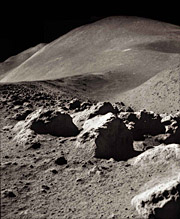 Apollo 15 Landed near the mountainous rim of the vast
Imbrium basin, on a lava plain cut by a winding valley like 'Rille'
believed to be a collapsed 'lava tube' cave. This view looking
down a 'bend' of Hadley Rille is among the best lunar landscape
images ever photographed. Unfortunately portions of the scene
had to be filled in using lower resolution material. Sometime
I hope to redo this image using more pristine material of consistent
quality. .276K
Apollo 15 Landed near the mountainous rim of the vast
Imbrium basin, on a lava plain cut by a winding valley like 'Rille'
believed to be a collapsed 'lava tube' cave. This view looking
down a 'bend' of Hadley Rille is among the best lunar landscape
images ever photographed. Unfortunately portions of the scene
had to be filled in using lower resolution material. Sometime
I hope to redo this image using more pristine material of consistent
quality. .276K
 An
Apollo 16 partial panorama showing the Lunar Roving Vehicle parked
next to a small crater. Hand colored from Black and white images.
520K
An
Apollo 16 partial panorama showing the Lunar Roving Vehicle parked
next to a small crater. Hand colored from Black and white images.
520K
 Just 30 years ago we reached the 'high water' mark
in the human exploration of space with the mission of Apollo 17.
This view of the Lunar Roving Vehicle on the landscape of Taurus
Littrow was prepared for publication from rather poorly copied
material. 543K.
Just 30 years ago we reached the 'high water' mark
in the human exploration of space with the mission of Apollo 17.
This view of the Lunar Roving Vehicle on the landscape of Taurus
Littrow was prepared for publication from rather poorly copied
material. 543K.
![]() This
Apollo 17 lunar landscape is a mosaic I prepared from images in
Kipp Teagues 'Project
Apollo Archive' site. I look forward to remosaicing the scene
using higher resolution material. 815K
This
Apollo 17 lunar landscape is a mosaic I prepared from images in
Kipp Teagues 'Project
Apollo Archive' site. I look forward to remosaicing the scene
using higher resolution material. 815K
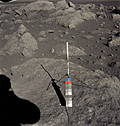 Apollo 17, the last manned voyage to the Moon, brought
back many excellent photographs. This one, taken at the same location
as the panorama above, has been color balanced to attempt a natural
appearance with minimal overexposure. 304K.
Apollo 17, the last manned voyage to the Moon, brought
back many excellent photographs. This one, taken at the same location
as the panorama above, has been color balanced to attempt a natural
appearance with minimal overexposure. 304K.
Apollo 17 and earlier such missions returned orbital views of Copernicus crater taken by hand held cameras from a similar vantage point as the famous Lunar Orbiter II view above. 660K
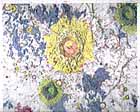 Geologic map of the Lunar crater Copernicus, by Eugene
Shoemaker, a benchmark in modern Lunar studies. The freshest (Copernican
era) craters are yellow. The relatively pristine craters whose
rays have been lost by the near surface being steadily disturbed
by small impacts over time, also formed atop the Maria lavas (Eratosthenian
era) are green. The mountainous rim of the giant Imbrium basin,
shown in blue, projects from above the lavas which partially buried
them. Thus the age relationships of Lunar materials were
mapped, in preparation for Apollo missions which would gather
rocks from similar locations and establish their absolute ages.
888K
Geologic map of the Lunar crater Copernicus, by Eugene
Shoemaker, a benchmark in modern Lunar studies. The freshest (Copernican
era) craters are yellow. The relatively pristine craters whose
rays have been lost by the near surface being steadily disturbed
by small impacts over time, also formed atop the Maria lavas (Eratosthenian
era) are green. The mountainous rim of the giant Imbrium basin,
shown in blue, projects from above the lavas which partially buried
them. Thus the age relationships of Lunar materials were
mapped, in preparation for Apollo missions which would gather
rocks from similar locations and establish their absolute ages.
888K
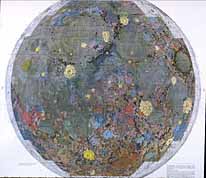 The great Lunar Earth side geologic map by Don Wilhelms
and Jack McCauley, and a host of others. Although later work has
greatly expanded the perspective available to later generations
of planetary geologists, this map marks a milestone in our understanding
of the history of our Moon. 1.3MB
The great Lunar Earth side geologic map by Don Wilhelms
and Jack McCauley, and a host of others. Although later work has
greatly expanded the perspective available to later generations
of planetary geologists, this map marks a milestone in our understanding
of the history of our Moon. 1.3MB
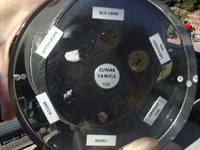 Someday if we return samples from Mars the direct
experience of the color of the surface materials will be possible
as it is now with Lunar materials. This sample selection of various
Lunar rocks and soils is seen here in direct Sunlight against
a black background. Some sense of the colors of the Moon seen
in the context of outdoor lighting can be gained. 148K
Someday if we return samples from Mars the direct
experience of the color of the surface materials will be possible
as it is now with Lunar materials. This sample selection of various
Lunar rocks and soils is seen here in direct Sunlight against
a black background. Some sense of the colors of the Moon seen
in the context of outdoor lighting can be gained. 148K
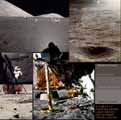 The color of the lunar surface is a slightly brownish
nearly neutral gray, with variations. Looking toward the Sun one
can best see what subtle color exists in the scene emphasized
by sunlit surfaces bouncing light into the shadows, doubly reflected
with the surface color contributing richly along the way before
reaching our eyes. This fills the shaded areas facing the sunlit
ground with a saturated version of the intrinsic ground color,
as is more easily seen in many colorful desert locations on Earth.
Looking towards 90 degrees from the sun provides a more neutral
color sense, influenced by the cumulative contrast effects of
adjacent sunlit and shadowed textures. the color of the sunlight
dominates as one looks toward their own shadow with the 'zero
phase point', where all shadows are covered by sunlit surfaces,
appears as a brightening around the shadow of ones head. This
is also where white sunlight is bounced back' by the many tiny
glass beads scattered in the 'soil', as with road signs using
glass beads. The sudden brightening of the Moon near full phase,
puzzled over before the Space Age, is primarily due to this effect
acting on the disk of the Moon passing through its 'zero phase
point' as seen from Earth. This montage was prepared for a Moon
related project suggesting reasonable approximations of true color
balance in various views and exposures.188K.
The color of the lunar surface is a slightly brownish
nearly neutral gray, with variations. Looking toward the Sun one
can best see what subtle color exists in the scene emphasized
by sunlit surfaces bouncing light into the shadows, doubly reflected
with the surface color contributing richly along the way before
reaching our eyes. This fills the shaded areas facing the sunlit
ground with a saturated version of the intrinsic ground color,
as is more easily seen in many colorful desert locations on Earth.
Looking towards 90 degrees from the sun provides a more neutral
color sense, influenced by the cumulative contrast effects of
adjacent sunlit and shadowed textures. the color of the sunlight
dominates as one looks toward their own shadow with the 'zero
phase point', where all shadows are covered by sunlit surfaces,
appears as a brightening around the shadow of ones head. This
is also where white sunlight is bounced back' by the many tiny
glass beads scattered in the 'soil', as with road signs using
glass beads. The sudden brightening of the Moon near full phase,
puzzled over before the Space Age, is primarily due to this effect
acting on the disk of the Moon passing through its 'zero phase
point' as seen from Earth. This montage was prepared for a Moon
related project suggesting reasonable approximations of true color
balance in various views and exposures.188K.